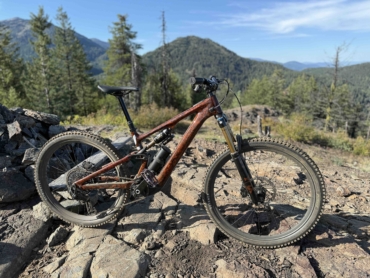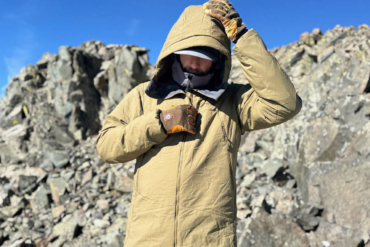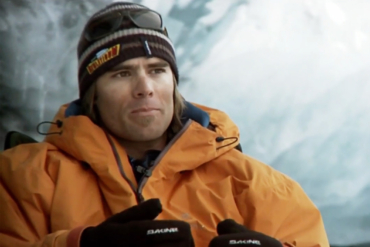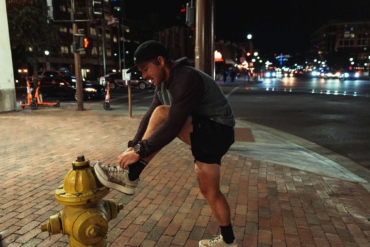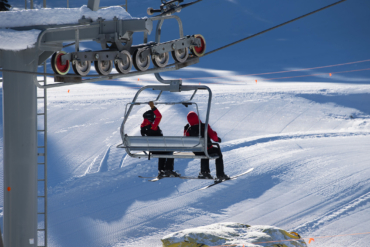Winter ultras combine the challenges of endurance racing with the season’s weather and extreme cold. To win, or even finish, takes perseverance and a little chill.

It sounds ironic, but you have to be pretty chill to pedal, run, or ski more than 100 miles in polar vortex conditions. For Kate Coward, it’s a specialty.
While she follows her passion for gravel races in the summer, Coward turns her attention to winter ultras as the temperatures drop. Her records and podium finishes have mostly come in winter bike ultras, she’s no stranger to skiing or hauling a sled on foot for days.
“I have this soft spot for winter ultras,” she explained. “At Iditarod, I did really well, just because there had been 12 feet of fresh snow, and there were moose everywhere. There was a big storm, and I lost my GPS. I didn’t have food or water for a day, and it was -50 [degrees Fahrenheit], and there was a whiteout. I thrive off chaos and suffering.”
We asked Coward about dressing for and racing winter ultras as part of Columbia‘s celebration of the “Chillest Humans.”
Even if you don’t have plans for racing such long distances, her strategies and advice may help you layer up out there. And we think her story will motivate you for your next cold-weather training ride or run.
Explore Columbia Omni-Heat Helix[KateColumbia_Hostpot1]
What Is a Winter Ultra?
For the uninitiated, winter ultras are long-distance races in the winter season over snowy, icy terrain. Most can be completed on skis, bikes, and on foot, with results posted for each discipline. The distance and extreme weather require hauling gear along too, with extra layers and a bivy for cat-napping.
Winter ultras owe their start to the Iditarod Trail in Alaska. Iterations of human-powered races using the same trail eventually turned into official race events and inspired them elsewhere in the world.
Early winter ultra-athletes often used skis and bikes. In fact, a lot of them were behind the first wave of fat tire bikes that have become popular winter staples.

The winter race season in Alaska typically starts with the Iron Dog snowmobile race, which also serves to groom the old historic trap/routes. Then, the bike races and runs happen. Later comes the ultralong Iditarod Trail Invitational sled races, and then the iconic Iditarod sled-dog races.
Most winter ultras still take place in Alaska, with some in Canada, Minnesota, and Wisconsin. The prominent winter ultras include the Susitna 100, the Arrowhead 135 in Minnesota, the Tuscobia 160 in Wisconsin, and Jay Petervary’s Backyard Fat Pursuit, a 200K ski, run, or ride event in the Greater Yellowstone area.
Coward tends to concentrate on fat tire races, but she does it all. And she prepares and dresses differently during these extreme pursuits.
Why She Races Winter Ultras
Coward’s first ultra was in 2016. She saw friends of friends do Arrowhead and wanted in.
“If other people are doing it and it looks cool, I want in. That’s how I ended up doing eight IRONMANs over the years,” Coward said.
Those past achievements helped her get an entry to Arrowhead. But she didn’t buy the requisite fat bike until a month before the race, of which she spent the first 12 hours figuring out how to ride the thing. Lowering her tire pressure and shedding a layer helped. She was the fifth woman across the line.
Since then, she’s completed Arrowhead on a bike, skis, and on foot. One year, when she was 8 weeks pregnant, she did the double. That’s where you start at the finish, make it to the start, and then go back with the regular race, for a 7-day, 270-mile adventure.
She’s won and set course records at Tuscobia, Arrowhead, and Iditarod on bike and ski.
Unlike other races, the adversity and survival components of ultras bring out her grit.
[KateColumbia_Hotspot2]
Dressing for Winter Ultras
Winter ultraracers don’t follow the same layering practices as other winter athletes like mountaineers or cross-country skiers. They tend to adopt more unorthodox strategies.
Minnesota and Alaska commonly see temperatures around -15 degrees F, and most apparel isn’t made for high-output activities in such conditions. Thus, winter ultra-athletes tend to Frankenstein their clothes, adding patches of heavier clothing and removing parts in other areas.
Coward said ultraracers tend to be big fans of zippers because they let you control body heat without stopping to shed layers. On top of that, she adds reflective strings to the zippers so she can grab them while wearing big mitts.
“Temperature control is one of the biggest factors in winter ultras,” Coward said. “You can do that through eating and drinking, but then you also need to be able to do that by letting air flow in or prevent it from flowing in.”
The same goes for adding oversized hoods to a favorite jacket. Coward said a bigger hood fits her hair and a beanie still with enough room left to create pockets of warm air around her head for added warmth and to warm the air she breathes.
Racers employ several strategies for trapping warmth and shedding perspiration. In general, there’s a wicking layer against the skin, and then either a bulky but breathable layer (even cotton) outside to trap warmth or a windproof layer that breathes less but retains more warmth.
One common strategy for keeping feet warm and dry is the vapor barrier approach. Typically, veterans wear a thin sock layer, then slip on a vapor barrier (which can be a plastic bag or a bootie), and then a thick sock layer on top. The thickness of the outer sock can vary by conditions, she said.
Columbia’s new Omni-Heat Helix tech aims to solve the same balance of needs. It uses a lightweight wicking material to move moisture and dry faster while keeping some body heat with a dotted pattern of foam cells. Ideally, that balance will manage your body heat during events with lots of starts and stops.
[KateColumbia_Hotspot4]
Columbia Omni-Heat Helix
Because of her busy schedule, Coward often rides an indoor trainer to get in her mileage while her children are home. However, Coward has trained in some of the Columbia Omni-Heat Helix fleeces and leggings.
On outdoor training runs, she’s worn the Women’s Outdoor Tracks Full-Zip Jacket with the Titan Pass Helix Leggings. According to Columbia, both pieces use the new Omni-Heat Helix for its breathable insulation and moisture-wicking tech.
The Outdoor Tracks Jacket is an active midlayer designed with a roomy fit. But it has a drawcord hem so you can pull it snug to keep out drafts. Its full zipper allows Coward to dump heat to her liking if she feels too warm. The Pass Helix leggings are more of an active base layer and include an odor-fighting treatment and a zippered hand pocket for securing essentials.
We’re well ahead of a winter ultraracing season, and, as you’ve seen, apparel for those conditions can get pretty niche. She has trained in some of the new Columbia apparel, and she could see herself wearing some of it during an ultra.
“In the foot division or ski division with a sled, I’d use it,” she said. That’s because the start-stop nature of those types of races requires shedding sweat and keeping your core warm.
On the year she ran the double Arrowhead, she wore an older Columbia fleece for most of that event.
“That worked out really well because I was moving slower,” Coward said. “It was big and bulky. I would have liked to have the Helix at the time for sure.”
[KateColumbia_Hotspot3]
What Kate Coward Wears
Coward makes her final gear decisions the night before based on forecasts. She dresses for bike races, where the wind is a bit more of a factor than the run-walk slogs of ultras on foot.
“I will push myself so hard that I’m dripping wet. I do that because I know if I keep going, I’ll stay warm and I know what to do if I get a mechanical and need to stay warm,” she said. She also carries a backup.
On foot, that’s not her approach. “I wouldn’t go running and sweat through because I wouldn’t be able to maintain that pace. In those conditions, I would manage my sweat more,” she explained.
In general, Coward wears a wool sports bra, a base layer, and a light shell that can shed snow and still breathe. In extreme cold, she’ll opt for a puffy vest in between.
“Breathing and drying fast is a core tenet,” Coward said. “Typically, wearing a puffy is more of a fear factor or backup for extra cold stops. But toward the end, adding more layers is common because your metabolism is slowing down.”
On the bike, she’ll push through and wait until a checkpoint to change base layers. With socks, she’ll swap one foot’s sock for a dry version at one stop, and then swap out the other foot’s at the next stop.
But we’re talking about winter ultras, so of course, there are other gear hacks and several strategies racers use to stay warm.

More Ultra Advice
As a veteran racer and former coach, Coward has seen many mistakes made. She gave us a run-through of some of the most common pitfalls.
Consuming large volumes of water is critical, but you have to keep it a liquid to drink it. There are insulated water bottles and hydration packs, but you need to know how long they will keep ice from forming.
She recommends ultrarunners experiment with 40-milers and 80-milers to get into winter ultras before diving into the longer races. That’s because the Arrowhead 135 and Iditarod 350 races require overnights. That compounds the cold, and sleep deprivation becomes an issue.
Winter ultra-athletes can consume 5,000 to 8,000 calories a day. That can take a few years to get dialed. Coward prefers the variety of real food during races and spikes her drinks with a flavorless carbohydrate supplement. However, she’s coached others who stick to a favorite gel and sports drink for days on end.
Coward has also coached other athletes on the mental aspect of ultraraces.
“These long-distance races — it’s all mental,” she said. “A lot of people go into these races and forget to train the mental game, and they don’t have a gameplan.”
When things get tough, they don’t have mantras or positive affirmations, and so they don’t know how to trick themselves out of those dark moments. She had one athlete who was racing across America, so his mantra was “you live here now.” He told himself that his bike was his couch and his handlebars were his TV stand.
Additionally, Coward has athletes visualize things like getting a flat tire in extremely cold conditions. “Your body doesn’t realize the difference between the visualization and the actual practice,” she said, “so you run through that scenario, visualize putting on a puffy, and eating more to get the metabolism up while you change the tire.”
Having run through it, even just mentally, helps avoid panic when something bad does happen.

Looking Ahead
This winter, Coward has her sights set on the Tascobia 160 by bike and perhaps the Arrowhead 130 on a kick-sled. She is one of two women to have completed that race on bike, foot, and skis. To tackle it again via kick-sled is an enticing possibility.
Beyond that, she’s looking at the Montane Lalpland Arctic Ultra race, which last year had no bikes. Or she’ll just put that energy into some big summer gravel goals. She’s also planning a bike trip to circumnavigate the Arctic Circle in Greenland.
Whatever adventures you have planned, consider layering up with the innovative fleece, Columbia Omni-Heat Helix.
Explore Columbia Omni-Heat Helix
GearJunkie’s “Chillest Humans” series, sponsored by Columbia, highlights athletes and adventurers who thrive in cold and extreme conditions outdoors. Find out more about Columbia’s Omni-Heat Helix apparel online.




